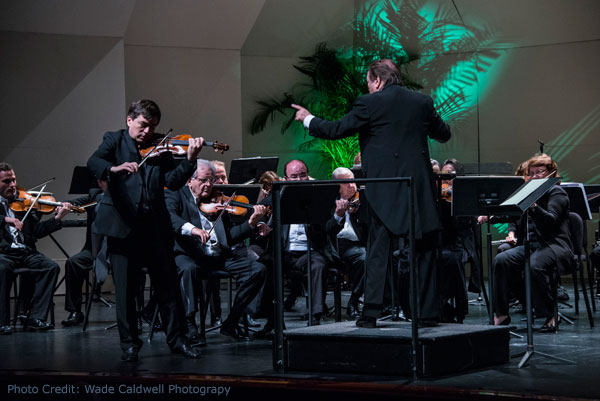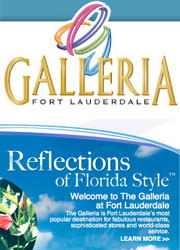
Italian violinist Roberto Cani joined the Symphony of the Americas on Tuesday night for a program of mostly late 19th century music from the golden age of artistic romanticism. Cani, who has played with the Ft. Lauderdale based ensemble several times in past seasons, was a late replacement for Florin Ionescu-Galati who was unable to obtain a visa to travel to the United States for the concert. Cani was nothing short of sensational. From the moment he played the violin's initial entrance in Henryk Wieniawski's Violin Concerto No. 2 in D minor, Cani's tonal gleam and sterling technique had the audience at the Broward Center's Amaturo Theater on the edge of their seats.
Wieniawski's showpiece is a gorgeous work, rich in melody and pyrotechnical challenges to all virtuosos who dare to attempt it in concert. Decades ago the score was a standard repertoire piece for touring international soloists. In more recent times, the concerto has been played much less frequently so this performance was doubly welcome. Wieniawski was one of the most important violinists and teachers in the later decades of the 19th century. His two concertos and numerous shorter pieces are wonderful showcases for the player's technical wizardry and Wieniawski was also an inspired melodist.
Cani is a consummate artist. He combines total mastery of his instrument with refined interpretive instincts. He swept through the concerto's double stops with total accuracy, pizzazz and showmanship. The concerto's beautiful second theme, which serves as a recurring motif, was aristocratically phrased, Cani's tone dark and rich. Cani rendered the long spun melody of the second movement Romance with a perfect mix of passion and elegance. His phenomenal technique was on full display in the Allegro con fuoco finale. Cani's rapid fire, flawless articulation was mixed with just the proper touch of gypsy infused paprika. Under James Brooks-Bruzzese's strongly focused direction, the orchestra provided fiery support.
The well deserved bravos brought an even more brilliant encore. Paganini's Caprice No. 24 is an oft played vignette, the main thematic material adapted by Rachmaninoff in his Rhapsody on a Theme of Paganini. Cani's dare devil performance took the piece one step further, his speed and dexterity a marvel. The variation in which he bounced the bow on the strings while plucking pizzicatos and the pianissimo variation in the violin's highest register were particularly stunning. In music that many players find technically impossible, Cani was truly remarkable.
The Wieniawski concerto was preceded by Rossini's charming Overture to L'Italiana in Algeri. This is Rossini at his bubbly comic opera best. The deft articulation of Marco Navarrate's oboe and the sparkle of Marilyn Maingart's flute propelled the overture's quirky secondary subject. Brooks-Bruzzese took the typically Rossini crescendo at full force. The entire performance was a delightful opener.
Cani's solo turn may have seemed a hard act to follow but Brooks-Bruzzese led a performance of Dvorák's too rarely played Symphony No. 6 in D Major that captured the score's Czech folk inflected roots with idiomatic fervor. This beautiful, large scale symphony is replete with wonderful themes and melodic fragments. In many ways the spirit of Johannes Brahms, Dvorák's friend and supporter, hovers over the symphony but in the most inspired manner.
Brooks-Bruzzese effectively conveyed the long arc of melody throughout the opening movement, bringing out the minor key modulations. Finely terraced dynamics conveyed the thematic transformations from solo oboe or soft strings to full throated orchestral statements. Excellent wind and string playing and the strong, solid brass fanfare near the movement's conclusion did full justice to the score's varied instrumental palette. The lyrical Adagio (second movement) displayed the string section's rich tone and the solo horn was spot on in accuracy and burnished sonority.
Folk like vigor was fully evident in the Furiant, the spirit of Dvorák's Slavonic Dances given full sway. The contrasting trio gleamed with scintillating wind playing. In the Allegro con spirito finale, the principal theme resembles that of Brahms Symphony No. 2, also in the key of D Major. Both the measured Brahmsian melody and the undertow of forward momentum came through triumphantly in Brooks-Bruzzese's carefully calibrated reading. The dance like episodes provided bouncy, alluring contrast. The full brass sonority in the movement's big climax was commanding and the difficult coda assayed with taut precision and assurance. This wonderful Czech score was led and played in a superb manner.
Richard Rodgers' Carousel Waltz was an enticing encore. The string and winds soundiedsumptuous, concluding the evening in a lighter vein with a touch of Broadway.
The Symphony of the Americas season continues with Opera to Broadway February 9 at 8:15 p.m. and February 14 at 2 p.m. at the Amaturo Theater in Ft. Lauderdale. Sopranos Danna Balson and Courtenay Budd, tenor Carlos de Antonis and baritone Marcin Bronkowski are soloists. For tickets and information 954-335-7002 www.symphonyoftheamericas.org




















